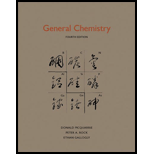
Interpretation:
Given species below has to be arranged into group of isoelectronic species.
Concept Introduction:
Electrons of an atom are arranged in orbitals by the order of increasing energy. This arrangement is known as electronic configuration of atom. This can be represented using noble-gas shorthand notation also.
Ions are formed from neutral atom either by removal or addition of electrons from the valence shell.
Each orbital has two electrons and they both are in opposite spin. Electrons are filled up in the orbitals of a sub-shell by following Hund’s rule. This rule tells that all the orbitals are singly filled in a sub-shell and then the pairing occurs.
Isoelectronic species are the ones that have different number of protons but same number of electrons. No two neutral atom can be isoelectronic. A neutral atom can be isoelectronic with an ion.
Explanation of Solution
Electronic configuration of
Fluorine has an
Electronic configuration of
Scandium has an atomic number of
Electronic configuration of
Beryllium has an atomic number of
Electronic configuration of
Rubidium has an atomic number of
Electronic configuration of
Oxygen has an atomic number of
Electronic configuration of
Sodium has an atomic number of
Electronic configuration of
Titanium has an atomic number of
Electronic configuration of
Argon has an atomic number of
Electronic configuration of
Boron has an atomic number of
Electronic configuration of
Helium has an atomic number of
Electronic configuration of
Selenium has an atomic number of
Electronic configuration of
Yttrium has an atomic number of
Isoelectronic species are the one that have same number of electrons. Therefore, the species can be grouped according to isoelectronic species as given below.
| Isoelectronic species | |
Want to see more full solutions like this?
Chapter 5 Solutions
General Chemistry
 ChemistryChemistryISBN:9781305957404Author:Steven S. Zumdahl, Susan A. Zumdahl, Donald J. DeCostePublisher:Cengage Learning
ChemistryChemistryISBN:9781305957404Author:Steven S. Zumdahl, Susan A. Zumdahl, Donald J. DeCostePublisher:Cengage Learning ChemistryChemistryISBN:9781259911156Author:Raymond Chang Dr., Jason Overby ProfessorPublisher:McGraw-Hill Education
ChemistryChemistryISBN:9781259911156Author:Raymond Chang Dr., Jason Overby ProfessorPublisher:McGraw-Hill Education Principles of Instrumental AnalysisChemistryISBN:9781305577213Author:Douglas A. Skoog, F. James Holler, Stanley R. CrouchPublisher:Cengage Learning
Principles of Instrumental AnalysisChemistryISBN:9781305577213Author:Douglas A. Skoog, F. James Holler, Stanley R. CrouchPublisher:Cengage Learning Organic ChemistryChemistryISBN:9780078021558Author:Janice Gorzynski Smith Dr.Publisher:McGraw-Hill Education
Organic ChemistryChemistryISBN:9780078021558Author:Janice Gorzynski Smith Dr.Publisher:McGraw-Hill Education Chemistry: Principles and ReactionsChemistryISBN:9781305079373Author:William L. Masterton, Cecile N. HurleyPublisher:Cengage Learning
Chemistry: Principles and ReactionsChemistryISBN:9781305079373Author:William L. Masterton, Cecile N. HurleyPublisher:Cengage Learning Elementary Principles of Chemical Processes, Bind...ChemistryISBN:9781118431221Author:Richard M. Felder, Ronald W. Rousseau, Lisa G. BullardPublisher:WILEY
Elementary Principles of Chemical Processes, Bind...ChemistryISBN:9781118431221Author:Richard M. Felder, Ronald W. Rousseau, Lisa G. BullardPublisher:WILEY





